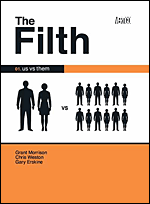
"Is all that we see or seem,
But a dream within a dream?"
- Edgar Allan Poe, A Dream Within a Dream
It's hard to be rational about the irrational; even harder to make the surreal real. Thus, trying to bring some sense to THE FILTH isn't easy. It's a slippery eel of a text that writhes under analysis, defying explanation. You can bring some sense to it eventually but... well it's complicated. In fact it's hard to even know where to begin...
DIGGING IN THE DIRT
Let's try the old Six Form essay technique of 'first define your terms'. Filth is defined by my dictionary as any foul matter that defiles, physically or morally; the obscene. It is also a slang term of abuse for the police. Morrison uses all these definitions, but also expands to provide a positive spin on things - a bit of the nasty can actually be good for you.
As you read this, your body is seething with myriad minute processes that you are totally unaware of. Your immure system works hard to expel unwanted material - going to war against the poisons and illnesses that invade the body. Millions of 'warriors' are sacrificed in the battle. In fact, what most of us think of as the 'symptoms' of our illness - the snot, the phlegm, the shivers, the aching joints, the headaches - are just the effects of the body fighting back, the dead corpses of all those warriors settling in the joints or being sneezed into a tissue or coughed up into the sink; we should welcome them.
We inoculate ourselves against viruses by deliberately injecting the 'filth' into our bodies so we can build immunity to it. That bit of nasty that is good for you - a bit of illness makes us well. As Nietzsche said, "That which does not kill us makes us stronger". In fact it has long been a worry that children are living too clean an existence, over-protected by mummy and daddy and not building up sufficient resistance. One of the things that makes THE FILTH so difficult to approach is that it is supposed to be having a similar effect on the reader on a intellectual, psychic and spiritual level. It messes with your head - but it does you good in the end.
Zoom out from the body, and we can see that our society at large has its own immune system to stop the poisons and diseases building up in the system. In the early morning while we sleep, dustmen clear away our rubbish ('dust' being an old euphemism for shit - now, of course, we have to call the dustmen 'Waste Engineers'). The police remove troubling individuals from the system just like the white cells in our blood that smother bacteria. THE FILTH is THE INVISIBLES for grown-ups; instead of young anarchists, it's about those unsung heroes who clear away society's mess.
This relationship of small to large, individual to society, is a recurring theme in THE FILTH. One obvious example is the I-life - a society of semi-intelligent microscopic Teletubby-like creatures. They infect an android creating their own 'starship' (it is implied that we are all 'starships' to our microbes). In the final episode we see a human being 'piloted' by little men in his head... is this a direct homage to very similar old Numbskulls comic strip from THE BEANO? According to Morrison, yes; "The Numbskulls were a major influence on THE FILTH," he admits, "along with Gerry Anderson's CAPTAIN SCARLET."
THE RUBBISH MEN
The Taoist master Chuang Tzu once dreamt that he was a butterfly. When he awoke, he thought to himself, "Was I before a man who dreamt about being a butterfly, or am I now a butterfly who dreams about being a man?"
At its heart, THE FILTH is about two characters who are two halves of the same person ... or are they?
 We start with Greg Feely. Well actually we don't; we start with what, at the time, is a totally unexplained page with a character going on about how 'smoking is like violence'. The many sudden similar non-sequiturs are one of the things that make THE FILTH's plot so hard to grasp the first time around. Each issue we are thrown straight into the action (literally 'without warning' in the third.). Also like a lot of surrealism, much of THE FILTH works on the subconscious level. After multiple read-throughs, the plot eventually starts to make some sort of sense (although, like some drugs, multiple exposures have a lessening effect on its weirdness, its magical effect).
We start with Greg Feely. Well actually we don't; we start with what, at the time, is a totally unexplained page with a character going on about how 'smoking is like violence'. The many sudden similar non-sequiturs are one of the things that make THE FILTH's plot so hard to grasp the first time around. Each issue we are thrown straight into the action (literally 'without warning' in the third.). Also like a lot of surrealism, much of THE FILTH works on the subconscious level. After multiple read-throughs, the plot eventually starts to make some sort of sense (although, like some drugs, multiple exposures have a lessening effect on its weirdness, its magical effect).
We first see Greg through the post-modern framing device of the CCTV camera, and he's surrounded by paranoia-inducing whisperings - or is he just suffering from schizophrenia? On a seemingly typical day in his life, we discover he is a sad tosser buying transexual pornography. "Good wank!" the newsagent advises him, to Feely's acute embarrassment - like the best surrealism, the Filth is shot through with humour. But at least Feely loves his dying cat, one aspect of his personally that gives us some sympathy for the character.
Morrison claims he didn't realise that Greg Feely was the moniker of a prominent US science fiction critic. "I don't read science fiction or any other kind of fiction so I'd never heard of the guy," he says. "Greg Feely was a parallel earth version of me, where life didn't work out, so 'Greg' means 'great' - as does 'Grant' - and Feely has the double meaning of touchy-feely and creepy-crawly."
The secret identity has a long history in comics, and Feely is also Ned Slade (or is Ned Slade also Feely?) Ned is the top agent for The Hand, a secret organisation with its headquarters in the 'crack of the world'. The Hand is a secret police force combined with cosmic dustmen (they even travel in dimension-hopping dustcarts) who eliminate 'aberrations' from the system. Ned's world is stuffed full with surreal imaginary. "The 'surrealism' is just my acid-trip version of typical comic book imagery, included because I wanted the book to be visually arresting and fantastical as well as thematically dense and 'realistic'," says Morrison.
FILTHY LOOKS
Grant worked closely with artist Chris Weston to achieve his vision. As Weston says, "Grant sent me a rough sketch of the Filth Officer's costume, and I slightly adjusted it to suit my vision. He's a good artist. He also designed the Status Quorum characters." There are also some interesting examples of technology, harking back to science fiction's past. Weston again: "I wanted to create science-fiction visions we hadn't seen since the Seventies; to make it look like the sort of artwork you find on the covers of science fiction paperbacks.
"The technology was supposed to look pre-STAR WARS, pre-BLADE RUNNER; to get away from that bulky, lived in, used hardware look that has been done to death these last two decades. Grant asked me to make it look like 'Roger Dean gone horribly wrong'! CLOCKWORK ORANGE and LOGAN'S RUN were also mentioned. I think I was only partially successful in realising this vision, and it's something I want to pursue further on future projects."
 Feely is supposedly some sort of holiday for Slade, a 'para-personality' he has assumed to take time-out from his vocation, which was so stressful that it had induced a break-down. Slade is forcibly brought back from his holiday - Feely's 'para-personality' stripped away - in order to combat the super-villain Spartacus Hughs. He was a former agent, and friend of Ned, who has gone bad and is now a 'cancer' in the system.
Feely is supposedly some sort of holiday for Slade, a 'para-personality' he has assumed to take time-out from his vocation, which was so stressful that it had induced a break-down. Slade is forcibly brought back from his holiday - Feely's 'para-personality' stripped away - in order to combat the super-villain Spartacus Hughs. He was a former agent, and friend of Ned, who has gone bad and is now a 'cancer' in the system.
The main plot consists of a number of set pieces where Slade battles against several spectacular disasters unleashed by Hughs' machinations. They are quickly resolved when each could be the basis for a much longer adventure - Morrison delights in showing off just how deep his imaginative power is when he can 'waste' such ideas. We have rogue nano-technology, an uprising on a massive ocean liner and the adventures of super-fertile porn film star Anders Klimaaks.
This latter episode is by far the most controversial. As Weston says: "Some of what I drew for the series was deemed too extreme and was hastily re-drawn; in particular, the Anders Klimaaks chapters. For example, the shot of Anders' black jizz spurting over the porn actress' face was removed!"
There was also some deliberate censorship, as a mad porn-film maker in the same episode has the world's first 'real pixelated penis'. This is just one example of a number of occasions where Morrison uses such post-modern devices to dismantle the comic book form (as Alan Moore did in a different way with Watchman). Later we have a character whose thoughts in the standard (but now old-fashioned) comic thought balloons are actually 'real clouds'.
There's also a comic within a comic, STATUS QUORUM, which illustrates the utter banality of the characters and plot from comics past compared to the cutting edge of now (ie THE FILTH itself) as the characters from STATUS QUORUM interact with those of THE FILTH. It's clear Morrison worked closely with Weston to achieve the spectacular and mind-dislocating first appearance of Status Quorum. "The page layouts and storytelling decisions were my domain," says Weston, "with the exception of that sequence in issue three, where the characters burst out of the comic reality. Grant sent me some roughs of the layouts he wanted for those double-page spreads"
Meanwhile, in the 'real world', in between Ned's adventures, Greg's life disintegrates - his neighbours outs him as a paedophile and he's eventually arrested by the police. Here Morrison taps into one of the UK's most prominent current urban terrors - the child molester - or even worse, being wrongly accused of paedophilia. In recent years we've had the News of the World's controversial 'naming and shaming' of paedophiles, leading to marauding hordes on council estates going after any weirdo or oddball (and even paediatricians).
TALKING TRASH
The story flips between Ned and Greg until both threads reach their climax in the final episodes, with many reversals in tone and plot along the way. In the final issue it's not exactly obvious what's going on, as several new themes and ideas are introduced (including the 'Numbskulls' as already mentioned). We have to develop new paradigms as the plot undergoes several quantum shifts.
 However the main themes are worked out - a little of the nasty does you good; good comes things come from bad - just as flowers come from muck and even life itself came from the primeval mud. On Morrisons' Crack Comics website there are a number of quotes for each episode, with one for the final issue seeming particularly apposite: "University of Glasgow chemist A Graham Cairns-Smith ... suggested that the present essential elements of biology - nucleic acids and catalysing proteins - evolved on a kind of prebiotic scaffolding. Ultimately the scaffolding disappeared, leaving behind the biochemistry that now controls the processes of all living things. The vanished supporting structure, in the view of Cairns-Smith, could have been clay."
However the main themes are worked out - a little of the nasty does you good; good comes things come from bad - just as flowers come from muck and even life itself came from the primeval mud. On Morrisons' Crack Comics website there are a number of quotes for each episode, with one for the final issue seeming particularly apposite: "University of Glasgow chemist A Graham Cairns-Smith ... suggested that the present essential elements of biology - nucleic acids and catalysing proteins - evolved on a kind of prebiotic scaffolding. Ultimately the scaffolding disappeared, leaving behind the biochemistry that now controls the processes of all living things. The vanished supporting structure, in the view of Cairns-Smith, could have been clay."
And in the end, with the memory of his cat guiding him on, Greg disappears underground as he continues to bring light to the darkness, the flowers blooming around him.
So what is actually going on? The obvious interpretation is, everything is happening as we are presented with it. Greg really is Ned. Another interpretation is that Greg is a having a breakdown and everything, including Ned's adventures, is his experience of the world as filtered through his damaged psyche. Or is the whole story just Greg's dying hallucinations after his overdose (strongly reflected by the death of Ned' nemesis in issue two)?
All these interpretations are equally valid. Says Morrison, "It's like any piece of music or painting. I have several interpretations of the story running simultaneously in my head. In the literal interpretation, the story actually starts at the end, when Greg takes the pills. Those five pages, the only ones to feature Greg as a narrative voice, are the 'real' world, and everything else is a Bardo experience, rippling out from that moment. When Greg says 'I'm coming...', he's having a kind of deathgasm, you might say, and reaching a blinding understanding of the universe all at the same time.
"In the I-life immune system interpretation, it becomes the sci-fi story of the creation, fall and evolution of a microscopic robot species programmed to heal. Greg's experience of the hand is a kind of 'sickness' - the presence of nano-life replacing the bacteria in his body is experienced as feverish hallucinations. Illness and then recovery. And so on."
MUCK AND MAGIC
Morrison is known for infusing his work with sigils and magical resonance, but what does magic mean in this context?
It's easy in our rational world to immediately dismiss it, but think of this... Every night, millions of people sit down in front of a 'magic box' and watch their soap operas and other dramas. The fictional characters are as 'real' to them as their own friends and families - they can talk about them like they are real people. For some they are more real. The actors receive fan mail addressed to their characters asking for work and offering marriage proposals. Actors playing villains are physically attacked in the street by members of the public.
But even if we are not soap fans, we all care about fictional characters, and fiction can deeply affect us. We are dragged into Greg and Ned's world (Greg being highly sympathetic, despite his negative character traits) and we become concerned for them and other characters due to Morrison's writing and Weston's art. We are affected by what we read. Someone's imagination is projected into your brain, leaving you changed... and that is magic.
Each person approaching a text will bring with them different experiences that will affect how he perceives the work. For me, but maybe not for you, THE FILTH was deeply affecting. Some things I took out of it were not even intended by the authors. While reading, I became convinced that the inclusion of a pair of artists who enjoy playing with filth may be a key to unlocking the text. I asked Morrison why he used Gilbert and George for Man Green/Man Yellow. "They crawled up out of my subconscious in that form. It just seemed right," he explained. Ah, well...
Could reading THE FILTH really change your whole outlook on life? Does the magic work? "I'd like to think so," says Morrison. "Your immune system should work better after reading it."

This article is Ideological Freeware. The author grants permission for its reproduction and redistribution by private individuals on condition that the author and source of the article are clearly shown, no charge is made, and the whole article is reproduced intact, including this notice.


